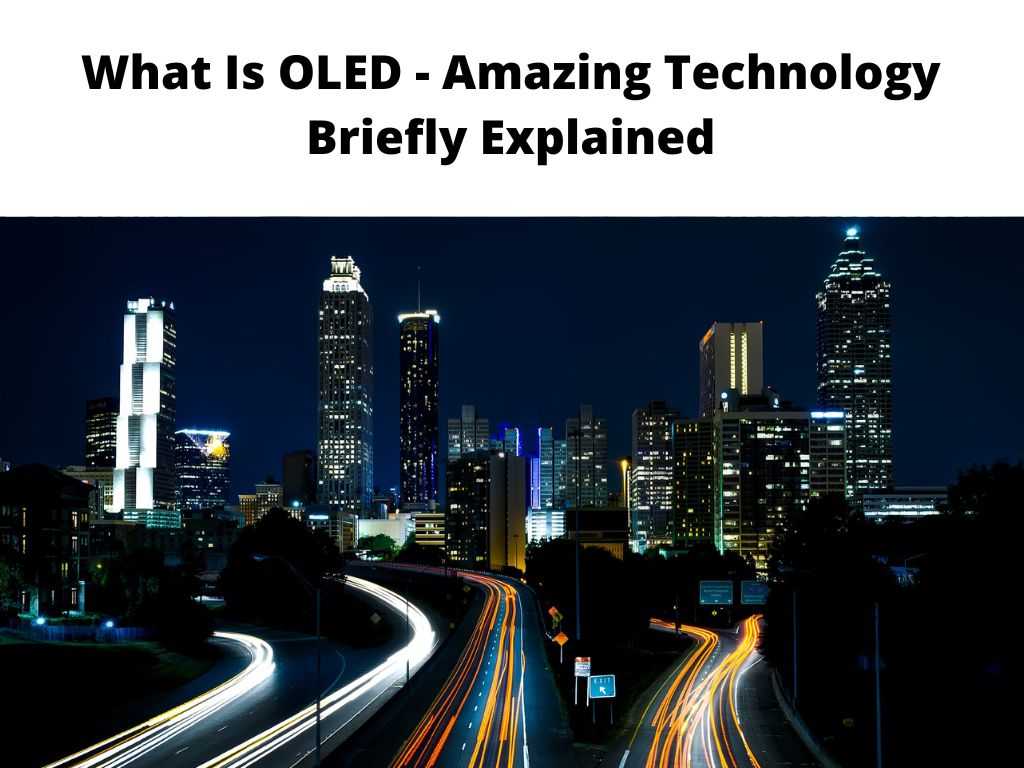You’ve seen those acronyms being tossed around in tech articles or perhaps on the side of a television box in a store – LCD, LED, and the increasingly popular OLED. But what does OLED stand for and why should you care?

This comprehensive guide will give you a captivating insight into the world of Organic Light Emitting Diodes, or as we all know them, OLEDs. Prepare yourself to be enlightened!
TL;DR: OLED, short for Organic Light Emitting Diodes, is a revolutionary display technology with unprecedented visual quality. They’re thin, flexible, and energy-efficient, promising the brightest, most vibrant, and ‘true to life’ colors. OLED displays are self-emissive, which gives them a competitive edge over traditional LCD or LED screens.
Scroll down to get a detailed answer
Let’s dig deeper into OLED technology and understand why it’s causing such a stir in the world of electronics.
Here’s how OLED compares with other display technology
| Display Type | Max Resolution | Contrast Ratio | Viewing Angle | Power Consumption (Avg. Watts/Hr for 55″ TV) | Lifespan (in hours) |
|---|---|---|---|---|---|
| OLED | 8K | Infinite | 178° | 90 – 100 | 100,000 |
| LED (Backlit) | 8K | 5,000:1 | 176° | 70 – 80 | 100,000 – 120,000 |
| LCD | 8K | 1,500:1 | 160° | 50 – 60 | 60,000 – 75,000 |
| Plasma | 1080p | 5,000:1 | 178° | 300 – 350 | 30,000 – 60,000 |
Table of Contents
The OLED Advantage
The numerous advantages of OLED technology have thrust it into the limelight. Being incredibly thin and flexible, OLED displays can be crafted into curved screens for immersive viewing experiences. Moreover, each pixel in an OLED display is self-illuminating, eliminating the need for a backlight and contributing to an outstanding contrast ratio that sets OLEDs apart from their LED counterparts. The result? Exquisite, lifelike images with vivid colors and deep, inky blacks.
Another compelling advantage of OLED technology lies in its impressive energy efficiency. Since each pixel lights up individually, areas of the screen that are meant to be dark consume little to no power. This makes OLEDs a more eco-friendly and cost-effective solution in the long run.
Illuminating the Mechanics of OLEDs
Now that we’ve whetted your appetite with the benefits of OLEDs, let’s delve into how these innovative displays work. Essentially, OLED technology uses organic compounds that emit light when an electric current passes through them.
Each pixel on an OLED screen comprises red, green, and blue diodes that light up independently. This is why OLED screens can completely turn off pixels, achieving perfect blacks and creating stunning contrast ratios.
Exploring OLED Display Types
There are two primary types of OLED displays – PMOLED and AMOLED. Passive Matrix OLEDs (PMOLED) are simple and cost-effective, making them suitable for small screens, like those on smartwatches. On the other hand, Active Matrix OLEDs (AMOLED) are better equipped to handle larger displays, like smartphone screens or TVs, offering superior resolution, refresh rates, and power management.
OLED Technology in Smartphones & Televisions
Many flagship smartphones and televisions now boast OLED displays, offering users the ultimate visual experience. OLED TVs produce extraordinary contrasts, rendering details in the brightest and darkest parts of an image with unparalleled precision.
Similarly, OLED screens on smartphones bring out vibrant colors and perfect blacks, taking mobile gaming and entertainment to the next level.
OLED Lighting
OLED technology isn’t confined to our screens. It’s also paving the way for a new era in lighting. OLED lighting panels are thin, flexible, and emit light uniformly across their entire surface, offering soft, diffused light that’s gentle on the eyes.
This could revolutionize the way we light up our homes and offices, offering a more comfortable and aesthetically pleasing alternative to traditional lighting solutions.
OLED Price Tag: An Investment Worth Making?
There’s no denying that OLED displays come with a higher price tag. The intricate manufacturing process and the relatively novel nature of the technology contribute to the cost. However, the impressive energy efficiency, superior image quality, and lifespan of OLED displays make them a worthy investment for many.
The Downsides of OLED
While OLED technology boasts many impressive advantages, it’s not without its drawbacks. Let’s explore some of the key concerns associated with OLED displays:
Burn-In and Image Retention
One of the most significant issues with OLED displays is the potential for burn-in or permanent image retention. This occurs when static content is displayed on the screen for extended periods, causing the organic compounds in the pixels to degrade unevenly. This can result in faint but permanent “ghost” images on the display. Although this issue is less common with modern OLED TVs due to advanced features designed to mitigate it, it’s still a potential concern, particularly for those who frequently display static images (like channel logos or video game HUDs) for long durations.
Lifespan
OLED displays have a finite lifespan, just like any other type of display. However, the organic materials used in OLED displays tend to degrade faster than the inorganic materials used in other types of displays, such as LEDs. This results in a shorter overall lifespan. As of my knowledge cutoff in September 2021, the typical lifespan of an OLED display was estimated to be about 100,000 hours of use before the brightness is reduced to half of its original level.
Cost
Due to the complexity and novelty of the manufacturing process, OLED displays are often more expensive to produce than LCD or LED displays. This higher production cost is reflected in the price tag for consumers. Over time, as the technology matures and economies of scale come into play, the cost of OLED displays may decrease, but as of now, they still carry a premium.
Limited Brightness
While OLED displays are renowned for their deep blacks and high contrast ratios, they typically can’t get as bright as LED/LCD displays. This is due to Automatic Brightness Limiter (ABL) circuits, which reduce the brightness of very large bright areas to protect the screen from overheating and reduce the risk of burn-in. This may make OLED TVs less ideal for viewing in very bright rooms.
Color Balance Shift
The different organic materials used for the red, green, and blue subpixels in an OLED display degrade at different rates. Blue, in particular, degrades faster than red and green. This can lead to shifts in color balance over time, although many modern OLEDs incorporate algorithms to compensate for this.
As OLED technology continues to evolve, manufacturers are constantly finding ways to mitigate these issues. Despite these challenges, the impressive visual quality and other advantages offered by OLED displays often make them a preferred choice for many consumers.
Conclusion
To wrap it all up, OLEDs, with their innovative technology and exceptional advantages, have the potential to redefine our viewing and lighting experiences. Despite the higher cost, the appeal of OLED technology is clear: superior image quality, versatility, energy efficiency, and potentially, a brighter, softer lighting solution for our living spaces.
As technology continues to evolve, it’s likely that we’ll see OLEDs becoming even more prevalent in the future.
FAQ
What is the difference between LED and OLED?
LEDs use a backlight to illuminate their pixels, while OLEDs have pixels that light up individually. This enables OLEDs to display deeper blacks and a wider color range, resulting in superior image quality.
Is OLED better than 4K?
These terms aren’t mutually exclusive – OLED refers to the display technology, while 4K indicates resolution. An OLED TV can also be 4K, offering the best of both worlds with exceptional color and high resolution.
Is OLED or LED better?
OLEDs generally offer superior image quality due to their high contrast ratios and true blacks. However, LED TVs are more cost-effective and have a longer lifespan, making the choice dependent on personal preferences and budget.
What is OLED and why is it better?
OLED, or Organic Light Emitting Diodes, is a display technology that uses organic compounds to emit light. It’s considered better due to its superior contrast ratios, vibrant colors, flexibility, and energy efficiency.


